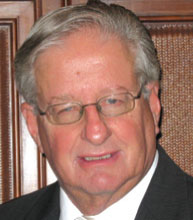 Donald Meichenbaum on CBT
Donald Meichenbaum on CBT
for Anger and Temper Control
By Lynn Mollick
On March 29 Donald Meichenbaum presented NJ-ACT’s 20th Master Lecture to 101 NJ-ACT members. According to Dr. Meichenbaum, anger occurs when there is a discrepancy between what people want and the way things are. Anger is a symptom of 19 DSM-V diagnoses, and is a consistent trait over the lifespan.
Dr. Meichenbaum’s research has identified 8 categories of events that trigger angry outbursts among parents:
1) interruption of plans
2) undesired outcomes or events
3) outcomes or events perceived as dangerous
4) expectations of how others should behave
5) repeated infractions
6) being overloaded/stressed
7) personal peeves
8) embarrassment
People with anger problems perceive more provocations than people without anger problems. These people respond too intensely with habitual “scripts” that reflect their view of the world as dangerous. To move from angry feelings to aggressive behavior, patients attribute intentionality to others’ “bad” actions and de-humanize the targets of their anger. They often believe that a code of honor or fairness has been violated.
Assessment
The therapist’s job is to help angry patients change the ways they habitually understand and respond to the world. Treatment should focus on helping angry individuals see provocations as problems to be solved, not threats. Cognitive change is the ultimate goal. Functional analysis is critical to CBT for anger and temper problems:
1. Consequences. Is the anger reactive or is it instrumental? Instrumental anger help patients achieve short term goals such as getting people in their environment or making them feel powerful. Aggressive behavior can also reduce tension. Ask patients questions about long term costs to develop motivation for change.
2. Triggers. When does anger occur and when does it not occur? What makes these situations different? Angry patients are hypervigilent about insults.
3. Cognitions. Angry patients engage in dysfunctional thinking, especially perfectionism, should’s, and black/white thinking. They attribute hurtful intentions to others’ actions and/or see events as unwarranted or unfair. They also hold expectations that are often wrong. For example, many angry parents expect children to be compliant, but research indicates that children comply to only 33 to 50 percent of parental requests.
4. Behaviors. How does the patient respond to provocations? Ask precisely what the patient did, not why they did it. What does the patient seek to accomplish with aggressive behavior? Patients often see only two alternatives: be aggressive or be taken advantage of. Treatment should offer additional alternatives. Share the functional analysis with angry patients. It helps them understand how they make decisions that begin with angry perceptions and end with aggressive behavior. Always assess the potential for violence to self and/or others.
Assess co-morbidity. Domestic abuse is 8 times more likely with alcohol abuse. Additional diagnoses require specialized treatment.
Never overlook assessment of angry patients’ strengths. Develop a time line of their accomplishments. Comparing this time line to a time line for symptoms and treatments builds self-efficacy and hope for the future.
Dr. Meichenbaum recommended several paper-and-pencil assessment tools: State-Trait Anger Expression Inventory II (Spielberger, 1999), Anger Disorders Scale (DiGuiseppe & Tafrate, 2004), Novaco Anger Scale and Provoation Inventory (Novaco, 2003), and Anger Treatment Readiness to Change Questionnaire (Williamson, et al., 203).
Treatment
Dr. Meichenbaum’s approach to treating angry patients is collaborative and highly individualized. It can incorporate all CBT techniques, but avoids the use of manuals. Instead of prescribing an intervention, let the patient choose a course of action by asking: “What can you try?” “Here are some ways that other people have handled this situation, might any of these work for you?”
The therapist’s principal task is to listen carefully and ask questions.
Angry individuals feel misunderstood and aggrieved, so therapists must show respect for their perceptions and display high levels of empathy.
Gentle questions are the therapist’s most important technique.
Dr. Meichenbaum gave many examples of useful treatment techniques. Highlights include:
1. Be paradoxical rather than critical. Frame whatever the patient says or does as useful to the treatment process. If they yell at you, thank them for letting you know how they feel. If they are silent, comment that you admire their thinking hard about treatment.
2. Teach patients to recognize when they’re getting wound up. Self-monitoring is helpful. Awareness of the rumination process can be followed by taking a time out, rational disputation, self-instructional training, or any other CBT technique.
3. Help patients develop an anger vocabulary. T here are many degrees of anger. Distinguishing them facilitates problem solving and communication
4. “Don’t let your amygdala hijack your behavior!” Explain the neurobiology of anger to engage patients in taking control and vanquishing their amygdala (automatic thoughts and behaviors).
Generalization and Termination: Dr. Meichenbaum asserted that it is not enough to change patients’ behavior. Patients must own the changes. When they report success, ask them “how did you do that?” They should be able to explain their rationale as well as the thoughts that motivated new, more effective behavior.
Ask patients “when you’re faced with a problem, do you ever ask yourself the same questions we ask in here?” This helps you determine whether patients are ready for termination. In successful treatment for anger, patients stop being victims of circumstance and start making active choices about how to think and behave.
Dr. Meichenbaum recommended melissainstitute.org as a source for empirically-supported information about anger and violence.